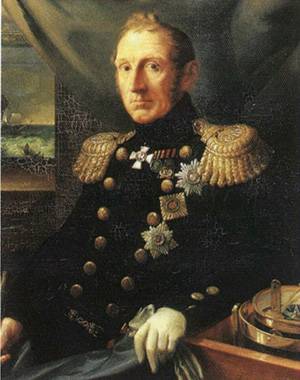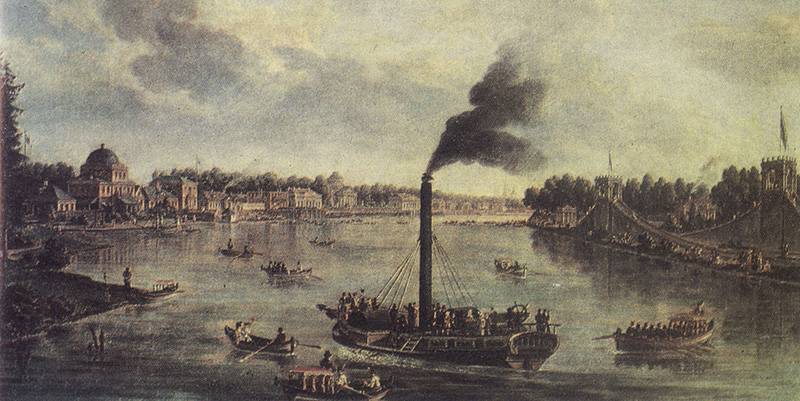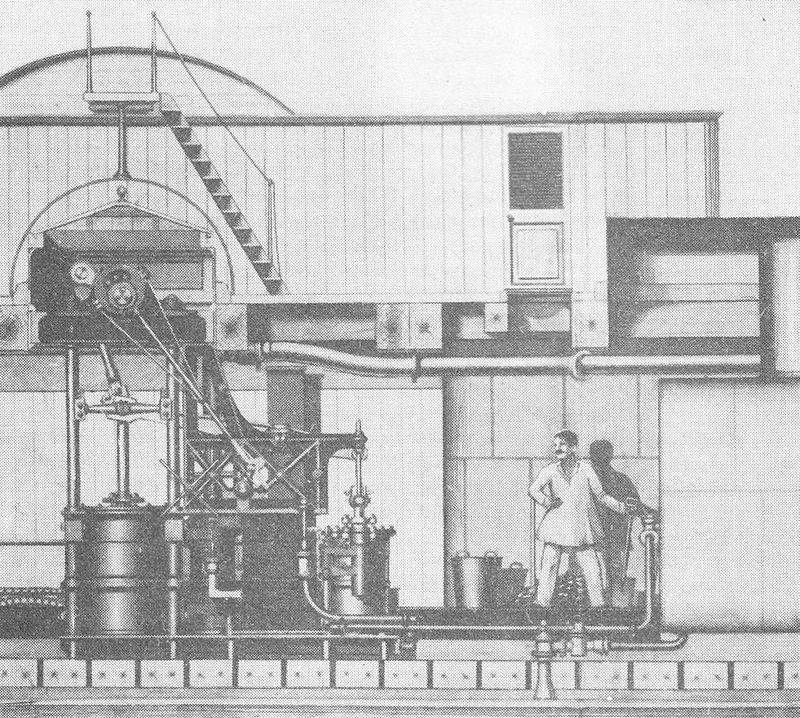Shipyard named after 61 communard. Revitalizing Shipbuilding Under Admiral Greig
The new commander of the Black Sea Fleet
Admiral Greig was distinguished from his predecessor by his capacity for work, potential and energy, as a tea clipper from a cargo bush. He was born in the family of the Scot Samuel Greig, who entered the Russian service as a captain of the 1 rank. His godparents were Empress Catherine II and Count Alexei Orlov.

The son of the famous admiral, Alexey Greig was born at the birth of a midshipman. In 1785, at the age of ten, the boy was sent to study marine business in England. Upon his return at the age of 13, he took part in Hogland battlein which the Russian fleet was commanded by his father.
Then Alexey Greig again sent to Albion, where he received the richest experience and floating practice. In England, Greig this time spent a long time: from the autumn of 1789-th to 1796 year. There he goes to the ships of the East India Company in the Indian and Pacific Oceans and as a volunteer of the royal fleet fights against the French.
In 1796, Alexey Greig returned to Russia, where Emperor Paul I produced 1 rank for his captains. Ahead of him was a successful career: the Baltic Fleet, the Adriatic and the Second Archipelago Expeditions. For the successful command of the compound of the ships that carried out the blockade of Danzig, Greig was awarded the title of vice-admiral. He was on good terms with the Emperor Alexander I, so his appointment in 1816 for the post of Chief Commander of the Black Sea Fleet was not accidental.
Greig's authority was based not only on the vast maritime and military experience, but also on his outstanding personal qualities. Formally, he did not receive a special education, since this school in his life was a deck, Greig was distinguished by an analytical mind, complemented by tremendous efficiency and self-discipline. It harmoniously coexisted naval sailor and scientist. Subsequently, in his declining years, he will become the founder of the famous Pulkovo Observatory.
Greig in Nikolaev. Battle for the oaks
Arriving in Nikolaev, Greig found local affairs in a state of sheer decay. For couriers from St. Petersburg to Nikolaev, the way is not close, it was even longer for the auditors and all sorts of drowsiness of service commissions. And all the terrible hails from the capital reached the peripheral south in the form of an inexpressive echo.
After examining the Nikolaev Admiralty, Greig began to revive him intensively. But even all the energy of Greig was not enough to instantly start the shipbuilding mechanism that had rusted from the Potemkin pores. The situation changed gradually. In 1817 and 1818 Finally, the heavily protracted construction of the Nikolai and Krasnoe 74-gun battleships was completed, and timber was prepared for the construction of the Flora 44-gun frigate.
By order of Greig, two existing large slipways were repaired and three more were built later, one of which was even larger. It was this boathouse, built on the right run of Ingul, intended for the construction of 110-gun battleships. The admiral made extensive use of his experience of being in England and the knowledge of the localities of the shipbuilding process.
By order and at the request of Greig in order to improve the procedure for lifting ships from the water, the British placed an order for a machine of the so-called “Morton device”. This device was developed by the English engineer Scottish Morton and was first tested in 1818 year. All the necessary mechanisms were made in 1826 in Edinburgh, after which they were sent by sea to Odessa. In the spring of 1827, work began on the construction of a Morton slipway, and in October, the first ship, the Sukhum-Kale transport, was introduced there on 1830.
Because of the ship forest at that time there was a whole interdepartmental struggle. Traditional sources of this raw material in Dnieper as a result of intensive logging have already been exhausted, and it was necessary to look for new ones. Oak forests suitable for size and age were looked after by officials of the maritime ministry in the Podolsk province, where there was a lot of quality oak. But the Ministry of Finance intervened in the matter, stating that state forests cannot be touched, since they are intended for logging and selling abroad.
At the end of 1819, a fierce investigation began between the two departments, with varying degrees of intensity, continuing up to the year 1822. In the end, the sailors managed to win the “battle for the oaks”, and the Ministry of Finance, with grumbling and reservations, released the Podolsky Forest from its grasping hands. A ship wood of a corresponding quality began to come to Nikolaev, though at a corresponding price. Delivery costs for wood from Kherson to 1817 – 1818 amounted to more than 60 thousand rubles, and this significant amount went only to pay the freight of civilian vessels. All these endless difficulties with the delivery of the forest, primarily due to the high cost of transportation, led Greig to an innovative technical idea.
First steamer
At the beginning of the XIX century in the world shipbuilding the introduction of the steam engine began to occur. By the time Aleksei Greig was appointed to the post of Chief Commander of the Black Sea Fleet, the Baltic already had some experience in operating ships with steam engines, which were manufactured at the Byrd and Izhora Admiralty plant. The admiral came up with the idea of organizing the transportation of wood from Kherson to Nikolaev with the help of steamboats.

As an experiment, it was decided to build one small vessel. According to calculations, it would be capable of delivering cargo from Kherson to Nikolaev in 24 hours, towing about 30 thousands of pounds of forest and moving from 4 speeds versts per hour. Such terms were not only beneficial for their brevity, but also saved significant funds. With proper maintenance, such a steam tug could quietly pay off in a year.
Greig, with all his inherent energy, set about the task. In April, the 1819 plant in St. Petersburg in St. Petersburg gave its official consent to placing an order: the manufacture of a power plant of two steam engines with a total power of 16 horsepower each, paddle wheels, a steam boiler and other equipment. The cost of the order was about 40 thousand rubles. In July 1819, the project of the future steamship was approved, the underwater part of which was sheathed in copper. The cost of the case was about 60 thousand rubles.
The first domestic steamers had, so far, very primitive and bulky balance steam engines with vertical cylinders. In the variant for the Black Sea Fleet, Byrd proposed to place two steam engines operating on one shaft. This was to ensure uniform rotation of the propeller wheels. Both cars worked from one common boiler.
In December 1819, the ship's hull was laid in Nikolaev. Its length was 28,6 meters, width - 6,1 meter, draft - 1,3 meter. Parts of the car were delivered from St. Petersburg by a special sleigh wagon train, and in the summer of 1820, specialists from the Byrd plant arrived for its installation and commissioning. In May, the steamboat was launched 1820, and by September, the assembly and installation of the steam engine was completed. The steamer, or, as he was then listed, the steam boat, was called the Vesuvius.
25 September 1820 for the first time in stories Black Sea Fleet "Vesuvius" made the transition from Nikolaev to Kherson - in one day. On the way back he already towed two ponds with a forest. Later, Vesuvius was actively used not only for transporting timber, but also in various towing works for the needs of the Kherson port.
Shipyard revitalization
At the beginning of the 20's Because of the uprising that began in Greece, relations between Russia and the Ottoman Porte began to slide back to the brink of military confrontation. In such a situation, St. Petersburg began to demand the quickest bringing of the Black Sea Fleet in proper condition. In 1822, the executive expedition specially created for this occasion requested allocations from the Maritime Ministry in the amount of 12 million rubles, of which almost 4 million were for shipbuilding programs and almost a million for ship repair.
The Ministry expectedly corrected this estimate. After all, the threat of war is not the war itself, and it was equally important to save money. As a result, instead of the requested 12 millions, the Black Sea Fleet should have received 9 million 800 thousand rubles. The Minister of Finance wanted to further cut the allocated amount, but not only Aleksey Samuilovich Greig, but also the Minister of the Sea de Traversay, came out to protect the fleet from "saving". Funding volumes have been saved.
By this time, Greig’s activities as the commander-in-chief of the Black Sea Fleet began to bear tangible benefits. It was during his time at the Ingul shipyard that the construction of the 100-gun ships began. In 1822, in Nikolaev, an improved Baltic project laid the 74-gun ship “Parmen”, which in the autumn of 1823, was launched. The 110-gun battleship "Derbent" and the 80-gun "Panteleimon" were laid on the vacant place and in the newly built boathouse in the autumn of the same years.
The increased volume of forest transportation directly pointed to the fact that Vesuvius needed an assistant. The decision to build a second steamer was made immediately. It was supposed to be larger than the "Vesuvius", and a much more powerful mechanical installation in the 60 horsepower was provided as an engine. She was also ordered by the well-established company Byrd and in February 1823, the sleigh wagon train was delivered to Nikolaev.
The ship itself, according to the approved project, began to build 1823 in March, in June, it was launched, and by the end of the summer, the engine was completed. Soon the "Meteor" (the so-called second ship of the Black Sea Fleet) was put into operation. Its operation was successful - the power increased by an order of magnitude allowed the Meteor to easily tow three ponds with a forest and two rafts. The project on the "Meteor" provided weapons, consisting of 14 guns. So the steamer could be used not only as a tug, but also as a warship.

In addition, at the initiative of Greig in these years, the construction of a steam excavator was carried out to further deepen the bottom and fairways. The mechanical part was ordered by Bird, and in August 1823 of the year was tested. Two 5 steam engines with horsepower each ensured the operation of the excavation mechanism. The productivity of this unit was much higher than the “fairway machines” used for this purpose on muscular thrust. In the future, given the positive operating experience, giving 300 thousand rubles of annual savings, Greig ordered to build a more powerful excavator. Her steam engine, which already had 20 horsepower, could provide fairway clearance to 7 meters.
Dredging works carried out over a number of years made it possible to completely and completely abandon camellia. Now it is possible to carry out a full cycle of building and equipping a ship at a shipyard.
Earlier, ships built in Nikolaev and especially in Kherson, were forced to be brought to the finished state in two stages: part of the work was carried out at the shipyard, and the outfitting and armament took place at Ochakov raid, which extended the construction period. A significant improvement in the situation with the fairways, complete wear of the camels, the appearance of steamboats prompted the Black Sea Fleet command to take such a decisive step as the elimination of the Kherson Admiralty in 1827 year.
Alexey Greig himself made the decision in the 1825 year, when the corresponding calculations were made. Construction of the ships of all classes now concentrates in Nikolaev. All craftsmen from Kherson together with the relevant institutions were transferred here. By the way, this idea was harbored by Prince Potemkin-Tavrichesky.
The farm of the Kherson Admiralty (at the request of the Governor-General of Novorossiysk and Bessarabian Count Mikhail Semenovich Vorontsov) was transferred in 1830 to Kherson merchants for the development of commercial coastal shipping in the Black and Azov Seas.
In parallel with the increase in shipbuilding production, the Nicholas shipyard was saturated with various new technological equipment. By the time Greig arrived in Nikolaev, there was already one horsepower steam engine in 6. It was used to support the work of the Epiphany Admiralty Textile, which supplied the naval and admiralty ministers with the uniform cloth. This unit, made in England, stood idle for several years because it was not in its original set. In the end, with the direct intervention of the Minister of the Sea de Traverse, the missing parts were manufactured at Izhora Plants.
Under Greig, the mechanization process intensified. In 1823, several lathes were delivered to Nikolaev. A little later, a machine for cutting metal sheets and a press for punching holes into them were brought here and assembled. The unit was used for the manufacture of steam boilers. All these products were domestically produced - manufactured at Izhora plants.
At the initiative of Greig, the necessary equipment was also procured in England, although it was significantly more expensive. Throughout all 20's. in the Nikolaevsk Admiralty, a fairly intensive construction of various production facilities was carried out. In 1825, the construction of a steam sawmill began on the right bank of the Ingul, which was finally accepted into the treasury from a private contractor only in 1831. The sawmill had four saw frames for receiving boards of various thickness. All machines, boilers and machinery were manufactured at Izhora plants.
The revival of Nikolaev as a shipbuilding center began to attract private capital. Near the Admiralty several non-state shipyards were founded. Their products were very diverse: from the 110-gun battleships “Adrianople” and “Memory of Eustathius”, built on the first guild owned by the Odessa merchant Mihil Silver Enterprise, to scuttles and pontoons for crossing the Bug.
There was a product of a different kind and technical level. The owner of another private shipyard, the Kherson merchant Markus Varshavsky, won tenders for the construction of the first cargo ship on the Black Sea for the port of Odessa. Monitoring the construction on the orders of Alexei Samuilovich Greig was carried out by an experienced specialist who already owned two built steamboats, the colonel of the shipboard engineers Ilya Stepanovich Razumov.
The Warsaw merchant pledged to build a steamboat of length 32 and width of 7,8 meters by August of 1827. However, the construction, as has happened more than once, was delayed, and the vessel called “Odessa” arrived at the port of registry only in July of the year 1828. 70 engine horsepower was manufactured at the factory Byrd. Soon the ship began flights on the line Odessa - Yalta, however, irregular. A trip on a similar vessel at that time can be figuratively compared to flights on a supersonic Tu-144 airliner from Moscow to Almaty. The cost of tickets to Odessa was very high: I class had to pay 60 rubles for class I, and 15 rubles for deck space. Operation "Odessa" lasted about seven years, and then was discontinued. Her car was installed on another ship. Warsaw himself, in the end, unable to withstand the competition, was forced to sell his boathouse and return to Kherson.
The rapid development of the Nikolaev Admiralty allowed the Black Sea Fleet to enter the Russian-Turkish war of 1828 – 1829. in a fully combat-ready and modern state.
To be continued ...
Information